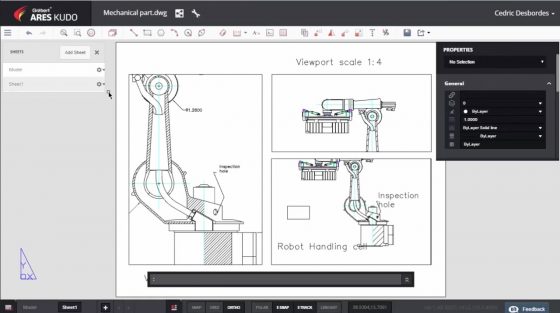An extended rollout will expose new features to beta testers over the next few months. Joining the ranks of cloud CAD vendors puts Graebert in exclusive company.
Graebert GmbH has begun a staged release of its newest product, 2D cloud-based CAD used in a browser. For now Graebert’s Ares Kudo is considered in the beta testing phase, only being released to a few users a day in North America and Europe as Graebert tests the capabilities of its cloud resources. The goal is to have a fully functional CAD product for retail before the end of the year.
Right now Kudo is only an engine for sharing and viewing .dwg files. Bit by bit features for drawing and editing dwg files in a cloud setting will be added until the product set is complete.

A “Trinity” for CAD
In October 2016 Graebert introduced an ambitious scheme for its next iteration of 2D CAD. Under the existing brand name Ares, Berlin-based Graebert announced a “Trinity” platform of desktop (Ares Commander), Mobile (Ares Touch) and cloud-based CAD in a browser (Area Kudo). One license for three products, and an online portal to manage rights access in multi-user environments. Of all the 2D/.dwg CAD products on the market, Graebert’s Trinity line is the most accommodating: Commander is available for Windows, Mac, and Linux; Touch is available for both Apple iOS devices and all devices in the Android universe; Kudo will cross all OS and device boundaries.
Graebert has no illusions millions of users will immediately rush to their new Trinity paradigm. “The transition to mobile and cloud in the CAD industry will obviously take years,” says Wilfred Graebert, founder and CEO. “In the meantime, we see desktop, mobile, and cloud coexisting. Our customers don’t want to be forced into only one of these options.”
Another way Graebert keeps options open is by letting the customer decide where the drawings will be saved. Instead of creating a special in-house system for saving and using the data, Kudo users can keep their files in Google Drive, Dropbox, or Box. Graebert says this accomplishes a trifecta of user control over data, lower costs for cloud-based CAD, and a separation of CAD editing (done on the Graebert servers) and CAD storage (managed by the user). Kudo also allows users to share views with others, by issuing a URL, thus taking advantage of cloud-based collaboration without creating multiple versions of a drawing.
What do we think?
If you already use cloud-based solutions like Salesforce.com or Google Docs, you know where Graebert is going — into a “any user, any platform, anywhere” paradigm. A user can do most work on a desktop computer, but over the weekend review some specific element of the drawing on a tablet, or on any computing device with a browser. The drawings are always accessible, and the user has legal software that fits the modern “anytime, anywhere” workflow.
2D CAD is still a big part of the technology marketplace, despite the lion’s share of attention going to 3D CAD. More than 8 million seats of Graebert-created 2D CAD are in use, second only to Autodesk AutoCAD and related products. If that number catches you by surprise, you should know that most Graebert products are sold by Dassault Systemès (DraftSight), Corel, (CorelCAD) or in partnership with Esri (Ares Map).
Autodesk, Dassault Systemes, and Onshape have individual cloud-based CAD products on the market. But when Kudo moves from beta to retail software, Graebert will have the market’s only CAD software — 2D or 3D — that offers the three platforms of desktop, mobile, and cloud under one license.
Autodesk is currently dealing with the elimination of perpetual software licenses, moving its users to a subscription licensing model. Wall Street loves it, but users — especially AutoCAD users — are not happy. Graebert’s new model provides incredible value for the money (it is thousands of dollars cheaper than AutoCAD) and makes it simple for companies to stay in compliance with license requirements and provide their users the access flexibility they require.





